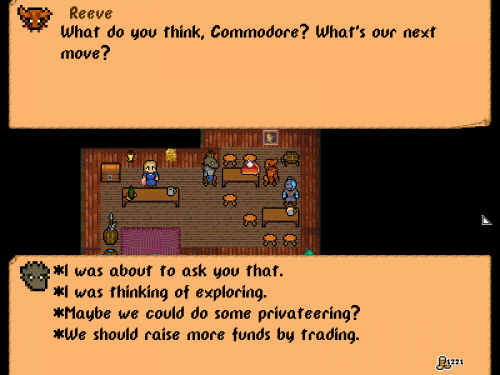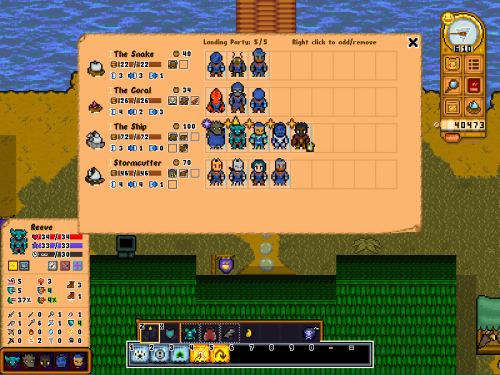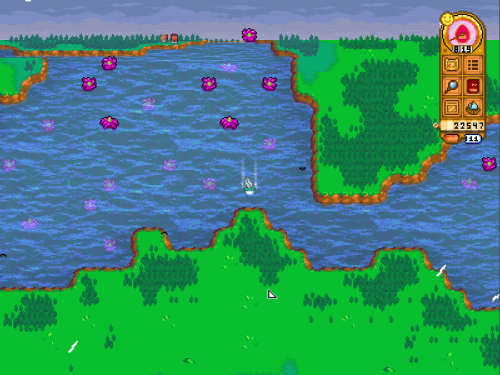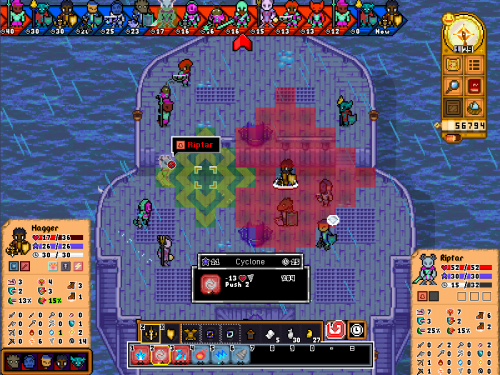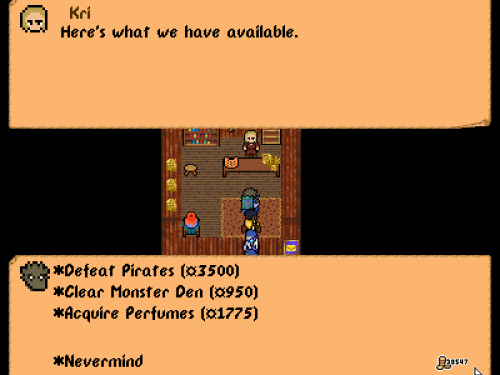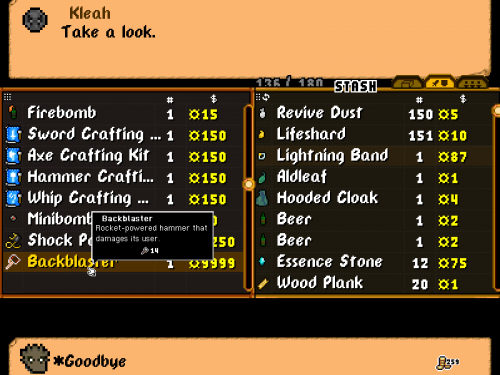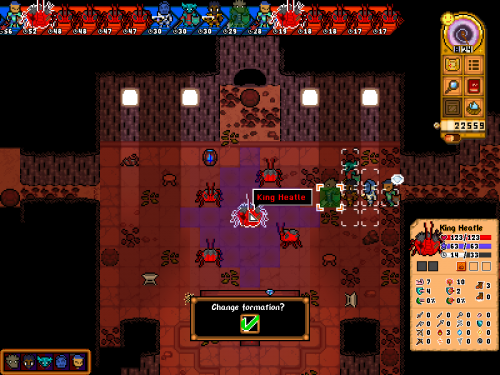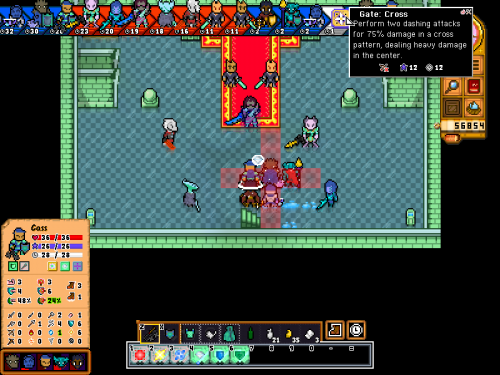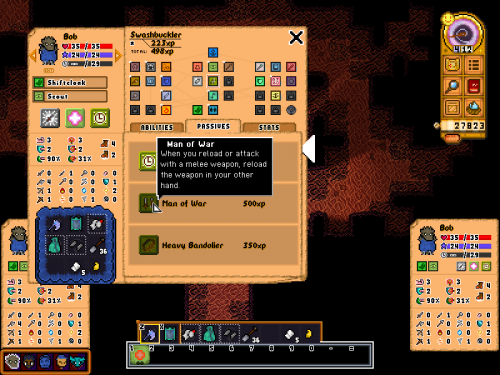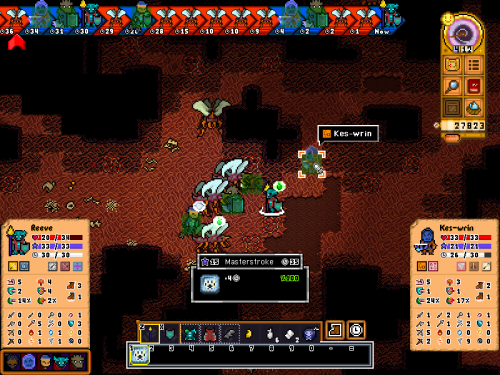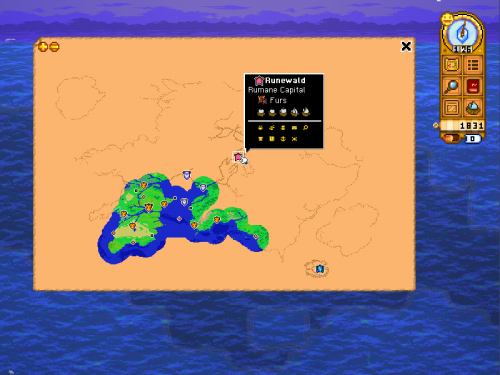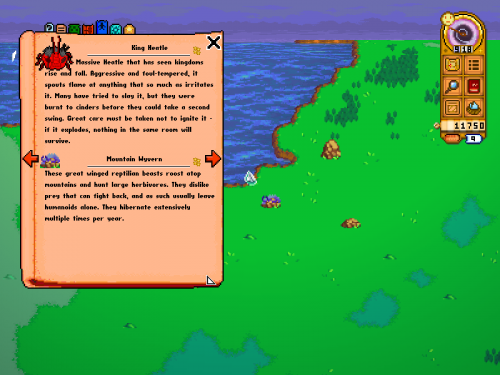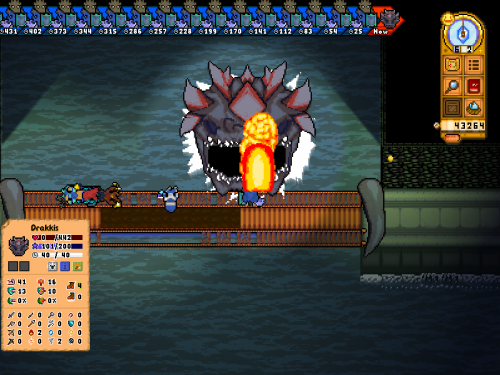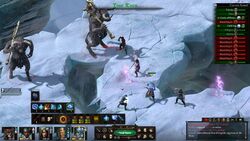RPG Codex Review: Horizon's Gate
RPG Codex Review: Horizon's Gate
Codex Review - posted by Infinitron on Tue 21 April 2020, 01:23:13
Tags: Horizon's Gate; Rad Codex[Review by CryptRat]
Released in 2015, Voidspire Tactics was a traditional CRPG inspired by games such as Ultima 7 and Final Fantasy Tactics. It allowed players to create their own party and explore a handcrafted, fully connected and highly interactive world, offering a deep character system with carefully designed tactical battles. For more details just read Jack Dandy's review. Using the same engine and taking a slightly different approach, 2017’s Alvora Tactics took place in an ever-changing, partially procedurally generated dungeon accessible from a central hub. It allowed players to recruit two party members in addition to the four player-created ones and included five new classes.
Returning to a handcrafted approach, Horizon's Gate takes place in the same universe as the previous games. It is a universe with its own lore, history and inhabitants, ranging from standard humans to the faceless rasmens who wear masks. The game puts you in command of a crew of sailors traveling around an inhabited continent and the surrounding region. The world contains multiple towns, dungeons and natural areas. There's no passage between locations other than by sea and the only way to travel from one location to another is with a ship.
After choosing your race, name and appearance in a disappointing character creation sequence where you only create one character instead of the four of the previous games, the game starts with an introduction and tutorial where your ship is sunk by pirates. After regaining consciousness on a beach you reach the pirates' cove and discover that the high admiral of Dominio, your own country, was responsible for the crime, for some political and likely evil purpose. Stealing a basic ship from the pirates and seeking revenge, you escape. You are joined by Reeve, a crew member of your sunken ship, ancient admiral and war heroine of Dominio. From there, everything is up to you. The game’s only objective is to assemble a fleet and crew so you can take your revenge and stop whatever the high admiral is up to.
Gathering the crew
Reeve can't be removed from your crew. She’ll have something to say the first time you enter certain locations and if she’s in your party you’ll be able to chat with her when you take a break at a tavern. You’ll soon meet another character willing to join your crew, though you don't have to accept his proposal. Additional crew members can be recruited at taverns throughout the game. A new inexperienced recruit, each with his own race and appearance, can be found at every port, and more will appear as time progresses, so your crew can grow quite large. The party you’ll use to explore on land is made up of five members of the crew and can be changed at will.
Of course, a crew would be nothing without a ship. Your fleet can contain up to nine ships, which you can obtain by either buying or capturing them. You can name any new ship that you buy. Different towns sell different types of ships, each with its own hull, cargo capacity, number of equipment slots, minimum crew size to move at full speed, normal speed, and speed modifiers with and against the wind. These attributes determine how well-suited the ship is for fighting or trading. The ships are completely simulated during boarding battles, during which you’ll be able to get a closer look at the special types of ships such as shell ships.
Sailing away
While at sea, your fleet is displayed as a single ship. The fleet’s speed depends on the speed of its slowest ship. It will be particularly slow if a ship has no crew members. Bad weather will also slow down your fleet. Game time only progresses at sea, pausing when the fleet stops moving.
New locations will appear on the map when the fleet gets close enough. The minimum distance is decent enough so don’t worry about hugging the coast to find every location.
A world map is available which shows the locations you’ve discovered. The map lists the services offered by each town, as well as the trade product it offers, whether you’ve visited its trainer and whether you’ve defeated the members of its dojo, when the town offers such services. Locations on the map can be marked by changing their icon into a different one, such as an exclamation mark or question mark.
While travelling at sea, your fleet can be struck by lightning which will cause your ships to lose some hull points. In deep waters, sea monsters will appear and begin chasing you. When they get close, unless they decide to flee or you decide to discard some food, a battle will start. You will also come across other fleets roaming the world. Enemies such as pirates will attack on sight, but usually you’ll get to choose whether to ask for a piece of information, trade, or engage in battle.
Products purchased from other ships at sea are more expensive than in towns, but price doesn’t matter when you're short of food in the middle of nowhere. The information you get from other ships or at taverns can be important too. Each month, one town somewhere in the world will buy a stock of a certain type of product for twice its normal price, which is something you’ll want to be aware of. You can also gain clues about a current quest and some details about game mechanics this way. If you engage in battle against another fleet and its ally is close by, then the ally will join the fight.
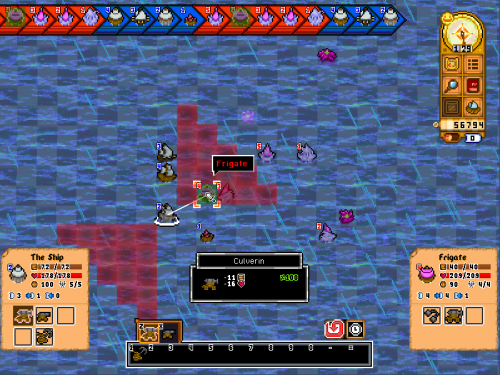
A sunken ship is gone for good, so battles at sea can be tense even though they’re not as complex as regular ones
Sea battles are turn-based, and their outcome largely depends on which side has the most solid ships and longest cannons. Cannons have unlimited ammo, which means the number of possible cannons on a ship is irrelevant. The differences between cannon types other than firepower are minor. However there are a few twists here. ships can't just move as far as their speed allows in any direction since turning is limited. Unlike characters, ships can move and then fire in the same turn, but except for a few specific weapons they can't fire and then move. Most cannons shoot from the sides of the ship while others shoot ahead or can target more than one enemy. Having more crew members, up to eight, increases the power of a ship’s cannons, as does being closer to your target. Dealing damage to a ship also affects its crew, which will prove useful when you decide to board an adjacent ship.
Basic grappling hooks allow the first five crew members of a ship to spend about three turns on an enemy ship to try and get rid of its crew. This is where allocating characters to your fleet is important, since a lonely sailor boarded by a group of pirates is bad news. The battle takes place on the boarded ship. Characters can push an enemy off the ship, though they may have to push twice to break the rail first. A character pushed into the sea can be pulled back out by his allies using appropriate skills. Broken rails remain broken from one boarding to the next, and characters keep their status effects such as poison as well. Morale also plays a role, so when you attack a fleet of merchant ships with armed battleships they often try to flee instead of fighting back.
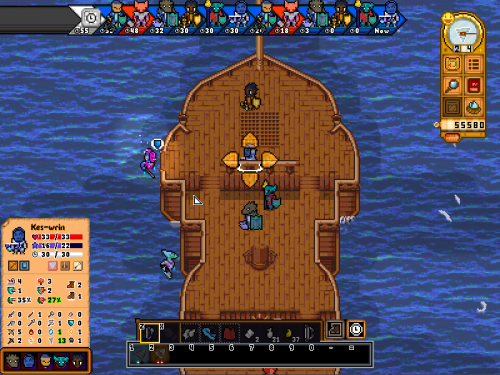
You don't need to kill all the enemies to capture their ship, just pushing them off will do the trick
After a victory, any sunken ships are gone for good. However, the crew and cannons from your own sunken ships can be recovered, and enemy cargo can be partially salvaged as well. Enemy ships which were defeated by boarding may be added to your fleet. Overall, the game’s sea battles work. Tactical options are fewer compared to ground battles, but unless you intentionally choose to do so, you probably won't spend much time fighting at sea. The real problem here is that sailing is just not very exciting. But exploration on land is a different story.
The inhabited world
Most of the game world is divided between three states - Jasce, a religious nation with an ostentatious visual identity, the representative democracy of Searth, and the kingdom of Rumane.
The towns you’ll visit offer various services. As sailors, you’ll find that the most important one is the tavern. New crew members can be recruited at taverns and you’ll frequently have to visit them to refill your party’s morale, which slowly decreases when you’re at sea. Suffering from low morale will inflict a penalty on your stats during combat and if it reaches zero the game is over. You’ll want to buy your crew members the unique food offered by each town, which will increase their morale and also provide a set of combat bonuses to your party for a few days. These combat bonuses can be stacked as long as each one comes from a different food.
Shipwrights sell ships and can repair yours for a price, while harbors stock superfluous ships. Markets sell cargo items, including cannons and other equipment for your ships, a single type of trade product, and food. Each one of your crew members eats one piece of food a day. Running out of food will cause your morale to decrease quickly to a game over and cargo capacity is limited to the sum of the capacities of your ships, so your fleet will need to grow if you want to carry trade supplies without the risk of running out of food.
Trade supplies are available in limited quantities, their stock being progressively refilled over time, and they can be sold at other ports for a profit. The same product might be available at several towns and the resell price depends on the distance from the port where you're selling it to the closest port which sells that type of product.
Other shops sell classic equipment - consumables and tools used during land exploration and combat. Different shops sell different items and there are several secret shops you can find around the world that sell unique items.
Guilds will pay you gold for completing various generally uninteresting quests, such as delivering a letter or exterminating a generic den of monsters which appears on the map only after accepting the quest. The guild quests to defeat a pirate fleet or kill a sea monster are slightly more engaging since they require you to do some hunting and may test the power of your fleet, but they’re still nothing special. You can't stack quests nor accept a guild quest while undertaking a nation quest, which means each quest is its own expedition. Listening to gossip at taverns may give you clues about your current quest.
You can “look” at everything in the game, from characters (who are distinguished by their class or their race) and mundane items to paintings inside bars to rare items and creatures. Their descriptions flesh out the world and can also be useful, revealing that a certain kind of tree reacts to lightning, that a turtle-shaped sea monster can be boarded, or that you can cut leaves into bandages. This information can also be sold to a researcher for money, while cartographers will pay you for exploring the world map. I appreciate the game’s sandbox approach and the way it offers multiple ways to earn money. It makes sense that researchers would value your exploration work and seek to fund your expedition. However, the game requires that you establish a contract with a single cartographer and a single researcher, and you need to continually return to them to get your money. This I don’t like. The game is at its best when you're moving forward in your exploration, and anything that forces you to sail back to where you’ve already been is a bad idea.
Trainers will unlock a new class in exchange for gold, or if you meet a certain fame requirement. Some trainers are hidden behind simple environmental puzzles. Once a class is unlocked, it becomes available to all characters.
Forges allow you to craft new equipment from raw materials and upgrade existing equipment.
Dojos offer one unique fight against a thematic party of characters with good rewards.
You can't attack people in towns, which is kind of a shame in such a highly simulated game world where you might want to play as a band of pirates. There are characters who offer bits of lore and some towns might have an unusual visual style, but few of them offer any unique services. There is one town with an arena that puts you in control of defeated characters in a series of battles.
Areas other than towns range from small to tiny. There are a bunch of generic two screen groves, seemingly procedurally generated, which contrast with the game’s otherwise almost entirely handcrafted content. As far as I’m concerned, they may as well not have been included in the game (or at least they could have been gated behind guild quests). These areas are tiny and often provide similar rewards. That said, the encounters in these areas, when there are any, are different from one grove to another.
Of course, there are plenty of unique locations in the game which are larger, although none of them is truly big. You will get to visit a jungle of toxic vines, a forest of explosive trees, a snowy plain with near-invisible wolves who clone themselves, an underground dungeon inhabited by jelly spell casters and what appears to be a cult of weird aliens, and a castle full of inflammable beetles. These locations each have their own aesthetic and bestiary, and they also feature a highly interactive environment, a staple of the series since Voidspire Tactics. All items including corpses can be dragged & dropped directly on the map. Digging with a shovel at suspicious spots, jumping over holes, cutting through vines and burning molds will all be part of your expedition. These unique locations are a pleasure to explore as you search for hidden treasure or a cave entrance. There might be some encounters that you can bypass on your way to the treasure and others that you can’t. A minimap is available, although with the small size of the areas you rarely need it.
Over the course of your journey, your fame will increase in three different ways. Combat fame is gained when you win battles, both on land and at sea. Exploration fame is gained as you uncover the world map, discover new locations and gather information. Finally, trade fame is gained when you earn profit as a trader, donate to a church or invest money in ports.
There are two reasons to invest in a port. First, each port has a wealth score which can go up to 100%. Investing in a port increases its wealth and a wealthier port will replenish trade supplies more quickly. Its shops will also sell more ships and items, including rare consumables and unique weapons, depending on the port. Note that investing enough money to get these strong items is expensive. To give you an idea, at the end of a regular game you may barely have enough money to unlock a strong item at a single port.
Secondly, you can choose to work for one of the three nations which control most of the game world. When you invest in a port, favor with your nation increases, and if the port is currently loyal to another nation, favor with that nation decreases. Furthermore, unless the port is one of those whose control cannot be changed, it will be loyal towards the nation that provides the highest investment, so investing enough money into such a port will change its loyalty. Roaming ships from other nations can invest money as well, so you might also see a port defect from your nation to another.
To gain favor with a nation you can deliver documents you find during your expedition to their leader or donate to a church. Working for a nation will provide additional ways to gain favor with them. I already mentioned investing in ports. Another way is to attack ships belonging to the other nations. As you might expect, sinking an enemy fleet will decrease your favor with the nation it belonged to. When your relationship with a nation becomes sufficiently negative, their ships will refuse to chat or trade with you, and their battleships will attack your fleet on sight just like pirates. When your fame reaches a certain level (determined by the highest of your three fame scores, thankfully), the nation you’re working for will ask for your assistance on a quest.
The nation quests are just as uninteresting as the guild quests. You might be asked to deliver a message to the leader of another nation or to find another generic grove based on its coordinates. Said grove will only appear on the map after you take the quest, so you might have to sail all the way back to an area of the world you’ve already explored and then return. The best nation quests are the ones where you have to acquire some rare (though not unique) item, which may require some work. Completing a nation quest will increase your rank with that nation.
When you reach a sufficiently high rank with a nation, food becomes less expensive in the towns they control. You will eventually be able to ask for an audience with the ruler and obtain various favors. Available favors include gold, ships, and also a temporary 30-day escort of ships that will fight for you but which you don't directly control. These ships are replaced for free after combat if any are sunk. You gain a rather mediocre reward for reaching the highest possible rank with a nation, considering the work required. You also gain access to that nation's intelligence, which means all of their ships become visible on the world map, but it’s not clear how that helps you.
As Reeve correctly informs you, choosing one nation or another has very limited consequences. I haven’t reached the highest rank with every nation but from what I've seen the types of quests are the same, with the same order. They’re not entirely the same, but then I'm not sure you get the exact same quests when working twice with the same nation either. The rank titles are different and the ships you can obtain are different. But I don’t mind the symmetry much. The real problem is that the nation quests are generally just rather boring. Working for a nation is optional, so at least during replays you can just ignore this part of the game altogether.
You can choose to realign with a different nation. Your new employer will demand a fee based on your rank with the old one. You’ll have to start from the bottom again and your previous employer will hate you. It’s useless so it’s fun. Note that when your favor with a nation is particularly negative, then the ports loyal to that nation won't let you dock freely. You’ll need to pay a small fee, sneak into the port during the night with some loss of morale, or intimidate the guards if your crew is large enough. Food prices are also higher in enemy ports.
There are multiple ways to earn money. You can work for the guild or a nation, explore groves and sell information about fossils, or board expensive ships and resell them. You can also assemble a fleet, invest in ports and develop your own trade network. You may not find all of these activities to be fun, but nothing is mandatory and there’s always something else to do. Compared to the previous games in the series, you won't struggle as much to afford basic items like shovels or bandages, but rare items, cannons and ships will be a challenge for much of the game.
Most of what I’ve discussed up to this point were those aspects of the game where it differed from its predecessors. Now let's talk about the core gameplay.
Combat
Combat in Horizon’s Gate is turn-based and takes place on a grid directly on the map. Characters can cast protection and enhancement spells before combat and can also initiate combat by attacking with a long range attack skill. Unlike the previous games in the series, battles begin with a formation phase where you can arrange your characters in a small area and choose the direction they’re facing.
The combat system is based on time-ticks, with a queue that takes note of the turn order and remaining recovery time for each character. During a character’s turn he can move and use an action, in any order. Not moving or performing an action will decrease the recovery time until his next turn. Recovery times are not otherwise determined by a character’s last action, and different creatures have different recovery times. There are certain skills that also require a preparation phase. They can be interrupted during this time, though simply inflicting damage won't be enough - you'll need to stun or disable the character or use an ability which cancels skills. Pushing the character will only do the trick if the skill’s effect depends on him being in his original position. Some skills also cost magic points to use.
Characters have the following stats: movement, physical and magical damage, dodge and damage reduction, proficiency scores in the various weapon types, which are added to hit chance and damage, and affinity with elements, which determines both the power of elemental attacks and the character’s resistance to those attacks. Backstabbing allows you to ignore the dodge stat. All damage values in the game are fixed.
You can inflict many of the classic RPG afflictions on your enemies - burning, poison, frost, silence, poison and disabling. An oiled character will take more damage and will automatically be burnt by any fire attack, while a wet character won't take much damage from fire but will take a lot from ice and lightning attacks. Electric attacks will spread in water puddles (likely created by a previous ice attack) dealing damage to all characters standing in them. Weapons can be charged with elemental power, and many elemental skills with various areas of effect are available, both to your party and to enemies. I found that you don't really need to care about enemies’ elemental resistance, but it's a good idea to pay attention to their resistance to afflictions.
The layout of the battlefield can play a decisive role in combat, especially when you can push enemies off cliffs using wind attacks. Shooting explosive plants from a distance can also be useful.
Encounter design is one of the game’s high points. Some of the creatures you'll encounter were already present in Alvora Tactics, while others are brand new. When you're not fighting against swarms of poisonous flies, worms which duplicate when damaged by weapons, explosive beetles, or monsters whose shells can only be damaged with hammers, then you're probably fighting against a party of characters who can use the same equipment and skills as your own. They’re quite effective at using skills, and you’ll get their equipment if you defeat them.
Enemies are able to use many different skills, are smart enough to get out of the impact zone of any currently charging skills, and will punish you for positioning your character in a way that allows them to target many characters at once. The enemy AI is unpredictable which can make for some fun battles.
You’ll get to fight against a few lone boss enemies with extremely high health and defenses. These fights may take a while depending on your damage output. Magic point restoration skills and healing consumables will prove useful.
As previously mentioned, some towns have a dojo that offers a challenging battle against a party of characters. They’re typically all trained in a single weapon type but have different classes. These battles are fun, and your reward for beating them is a powerful weapon and also the ability to increase the proficiency of your entire crew with that weapon type for a price.
A lot of information is available to the player during combat. The stats, resistances and passive skills of enemies are displayed, as are the classes of any characters. Creature descriptions may sometimes contain useful information. Before attacking, you get to see your chance to hit, chance of inflicting an affliction, and potential damage. Furthermore, you usually get to see all of the enemies in the encounter before deciding whether to engage in battle.
Knocked out characters are revived after combat and still receive experience, though they suffer a small penalty to their maximum health that can be regained while sailing. Health and magic points are quickly regained while walking, and since consumables are an abundant resource the primary challenge is at the level of the individual battle. Long-term attrition and resource management come into play when buying and crafting equipment, and of course during character development.
Your party can contain up to five characters. A character's race provides some stat modifiers. Among the races available from the beginning of the game, humans gain more experience, scurios (who look like cats) act faster, the faceless rasmens are immune to blind and silence and gain a bonus to dodge when flanked, fareems with their serpent tails can move further but act slower, the tall aphests inflict more damage but act slower, falpas with their many eyes have more magic points, the furry ferrens gain a bonus to magical defense and dodge, wilderis inflict more physical and magical damage and their tail increases their defense against back attacks, the buralks' shell increases their defense against both physical and magical attacks, and the lizard-like zylas poison any enemy who attacks them in melee. There are a few more races among the game’s recruitable characters.
Characters can reassign their classes at will. A character’s primary class provides him with a set of stat bonuses. Any experience points the character gains go to this class and can be spent on unlocking and upgrading skills and increasing stats. He can also use any of the unlocked active skills from his secondary class, as well as three passive skills regardless of his currently assigned classes.
As in the previous titles in the series, to unlock a new class a character must gain a certain amount of experience in one or more previous classes. What’s new in Horizon's Gate is that the party must also have met a trainer for that class. The game features all 23 classes from Alvora Tactics along with eleven new ones. However, the classes are more focused here, each one providing only five active skills compared to the seven in Alvora Tactics. Some of those missing skills were transferred to the game’s new classes while others have been discarded entirely. The number of passive skills per class is still three or more, the same as in the previous games, which means many new passive skills are available. Some passive skills from the original classes have been transferred to the new classes, but they’ve been replaced with new skills.
Mechanists have been renamed to bombardiers and can no longer set up turrets, though they can still throw various elemental bombs which need to be activated afterwards by the throwing character or another bombardier. All the other classes from Alvora Tactics are still there with their original names. For example the ignis knights, who with their natural affinity for fire can set themselves on fire to deal damage to the enemies around them, consume their own burning status or that of an enemy to inflict massive damage, or summon a phoenix to revive an ally while damaging the enemies around him.
Some of the old classes have new abilities. Shiftcloaks, who are effective with a gun in each hand, previously had the ability to reload both their weapons at once. That was replaced with the ability to reload their weapons whenever they use an ability that makes them move. Their new melee momentum passive skill increases the damage of their melee weapon based on the distance they covered during their turn. Enchanters, whose specialty is enchanting their allies' weapons with magical elements, have gained a new passive skill which allows their enchant skills to increase their own affinity with an element instead of targeting a weapon, so that it increases their defense and the power of their spells. Sages' healing spells, which target all characters inside a small area, now take time to cast, so I often choose to use consumables instead.
The new classes are interesting too, though as mentioned some of them aren’t totally new since they use active skills that previously belonged to other classes.
The gladiator’s skills all come from other classes in Alvora Tactics. Brawlers gained two new passive skills directly related to fistfighting, so gladiators got their reckless skill, which increases physical damage while decreasing defense in the first turn of combat, and their counter throw skill, which allows the gladiator to throw his melee weapon at an enemy in reaction to an attack. The gladiator’s weapon master skill is interesting, increasing their physical damage by a value equal to their lowest melee weapon proficiency.
Ravagers use weapons and ruin magic and also have many skills which were previously available in Alvora Tactics. The critical destroy passive skill, previously owned by defilers, allows ravagers to finish off nearby enemies with low health when their own health is low. The ruinshock skill, which can be used with both melee and ranged weapons, deals massive damage to an enemy at the cost of some damage to the ravager.
Elementalists got their active skills from the other mage classes, and they aren’t very different from those of sorcerers. They have a bonus to magic resistance, a passive skill which allows them to not take any damage when walking through fire and lightning, another one which increases their magic power by a value equal to their lowest elemental affinity, and a final one which increases the power and range of direct attacks with trigger stones.
Wardens have passive skills oriented around self-protection, along with protection spells taken from other classes. Their guard spell requires some preparation time and targets a selectable area, replacing the spell guardians used to have whose effect was centered around the user.
Gatewarders got their spells from the two other classes that use gate magic. They are resistant to magic and have a passive skill which increases the range of all their gate spells for the price of one movement point.
Some of the stormshot’s skills are very similar to ranged weapon skills that previously belonged to the spell archon. Stormshots can use ranged weapons combined with magic to attack multiple targets, and they also have the projectile mastery passive skill which reduces damage taken from ranged attacks by half, though it’s more expensive than it used to be.
The remaining classes are all truly new. Following the theme of the game, all characters now start out as sailors, with a bonus to physical attack and defense, the ability to revive a knocked out ally with one hit point, and passive skills that allow them to deal more damage when wet and move further when near water. Their rope skill allows them to pull a character out of water during shipboard battles.
Tacticians have various skills that involve moving allies around the battlefield, some providing an additional bonus to the target, and also have a skill which after it fires immediately grants a turn to all the other characters in the party. One of the tactician’s passive skills allows allies to act faster, while the other two increase their defenses at the beginning of combat while decreasing their movement speed and vice versa.
Krakenslayers are warriors with a natural affinity for lightning. They have a volt blast attack whose area of effect increases and damage decreases the farther its target is located. Their giantkiller passive skill increases the damage of melee attacks based on the maximum health of the target.
Swashbucklers win the style contest. They have a passive skill which reloads the weapon in their hand if they attack with a melee weapon in their other hand, as well as an active skill which allows them to shoot a target and then charge at it with the melee weapon.
Finally, minstrels cast spells which can cure, revive or restore magic points and morale to all allies wherever they are. Their battle caster passive skill increases their dodge stat while they’re preparing a spell, which they’ll need because their spells are quite slow.
This is only a small sample of the available skills. One thing you’ll notice is that the descriptions of the skills have been improved compared to the previous games. New icons have been added that tell you whether a skill uses physical and/or magical stats and what elements are taken into account.
Generally, unlocking new classes does not make the previous ones obsolete. One particularity of this series is that progression can become quite flat after a point. Maximum health won't increase by more than 50% over the course of the game, the base damage of most weapon types range from 5 for a typical steel weapon to 10 for a rare one, and the damage reduction for heavy armor is just 5. You'll put the same stones in your early weapons as you do in your late game weapons, and your affinity for one element or weapon proficiency can be increased by 3 points early on but won't go much higher than 3 more points for the rest of the game.
This has several pleasant consequences. Only at the very beginning of the game is the party restricted to easy encounters and a large majority of them will be well-balanced for your party no matter what stage you’re at. Only a few encounters require a truly strong party, which is a good thing because sailing back to port can take some time.
Furthermore, most if not all skills are designed so they can be useful even near the end of the game. Classes grant access to different sets of skills, offering the player more options instead of merely stronger ones. Physical damage is generally determined by a character’s weapon, while elemental damage depends on his affinity with the associated element. Finally, the strongest skills tend to have a lengthy preparation time which can make them difficult to use efficiently.
Elemental attack spells and many other skills have varying areas of effect and enemies are aware of them, which makes positioning important. All skills are combat skills, so there are no lockpicking skills or anything like that. However, many skills can also be used outside of combat, for example to get rid of a flammable obstacle or freeze water to create a path.
Active skills are inexpensive and fairly effective as is, providing you with more options during combat. However, most of them can also be upgraded a few times to increase their range, damage or duration, which can get expensive. This provides further customization options.
Classes allow you to increase various stats. Generally, the melee-type classes upgrade melee weapon proficiency, the ranger classes upgrade ranged weapon proficiency, and the mage classes upgrade elemental affinity. You'll eventually get enough experience points for all the skills you want to unlock, so there's no need to rush and find all the trainers in the world, although that’s something you can do if you want.
A character’s equipment loadout consists of two hand slots, an armor slot and two accessory slots. They can also carry four types of consumables. There are no class-based restrictions, so for example mages can equip any weapon or wear heavy armor..
There aren’t that many different types of consumables to use in combat, just a few healing items and bombs. One type of bomb is the heavy bomb, which causes massive damage but explodes only a while after being thrown, so they’re not easy to use.
Accessories provide various bonuses such as a bonus to dodge or immunity to some affliction. Armor usually increases defense or dodge scores versus physical attacks, though some heavy armors increase defense and decrease dodge.
The power of weapons is primarily determined by the material they’re made of. There are several types of weapons. Hammers ignore half of the enemy’s defense, spears can target two tiles, and flails can hit diagonally, which often means you won’t face a counterattack. Bows require two hands to use, while crossbows and many guns require only one hand but have to be recharged after each use. The ranges of these weapons vary and the more advanced guns can hit from a very large distance. Elemental rods and stones, which increase the affinity of a character with their associated element, can also be directly wielded to attack an enemy.
You’ll also find unique weapons over the course of your adventure, like a greatsword whose element changes after each use. Stones and similar items can be placed in weapons to add an affliction on hit or increase elemental damage, or in armor to add protection from an affliction or increase elemental affinity.

A spider fang can be used to add poison damage to a weapon or poison resistance to armor, or as a crafting ingredient for a poison weapon or poison-immune armor
You can craft equipment and consumables from raw materials. Sometimes you need to discover how to craft something by reading the descriptions or experimenting. For example, a leaf hood and leaf cloak can be combined, extra leaf hoods can be cut into bandages, and vests can be created from spider silk. There are multiple ways to use most types of raw material. For example, you might be able to use raw material to craft armor or any variety of weapon, so the game provides a lot of choice here.
Unlike the previous games in the series, you get an unlimited stash right at the beginning when you get your first ship, so there's no limit to what the party can carry and bags are worthless. You will use various tools during your adventure, and some unusual items can be found such as crests which allow you to use an active skill from a third class.
Conclusion
Visiting most of the world of Horizon’s Gate will take you about 20 hours. The game is quite complex, yet there are no load times and it was basically bug-free from day one. I’ve never regretted paying full price for Rad Codex's games and plan to buy their next game on release day. A few words about the user interface: The game now has a dedicated shopping interface, whereas previous games simply used bags. Overall the user interface is very good. UI elements can be dragged & dropped around the screen, the map can be resized, and combat controls, inventory management and environmental interactions are intuitive and pleasant.
The game’s graphics even at their worst are serviceable. The characters and monsters may look a bit cheap, but screenshots don't do justice to the overall effort put into the artwork. The game world is fully simulated and on display. ships look good. There’s a day/night cycle and a variety of environments, flora, elemental hazards and effects. Transitioning between interiors and exteriors looks cool, and every single item on screen is interactive. Equipment is visible on characters, who pull out their weapons during combat and wear them on their back otherwise. Finally, I think the scroll-like appearance of the user interface is rather nice.
The game’s music is unobtrusive and atmospheric at times and epic at other times, and in both cases it’s very nice.
The game offers several difficulty settings which can be changed at will. You can adjust food consumption and morale loss rates in case you hate having to stop at ports. On the highest difficulty setting, your fleet won’t be visible on the minimap. You can adjust the maximum amount of time the enemy AI takes to select an action, although from my experience enemies act instantly either way. Finally, there’s a difficulty setting that increases enemy stats, and the hardest setting also gives them more abilities such as counterattack skills. An ironman mode is available, and completing the game unlocks an experience multiplier setting as well.
Only the game’s introductory and ending battles are mandatory. On the default difficulty level, it’s actually possible to explore and trade for gold, buy a few battleships and defeat the last few bosses using bombs with your inexperienced party. The game’s journal contains a short list of objectives, a log of the descriptions you’ll come across, details about the various status effects, and a blank page where you can take notes.
One of the best things about Voidspire Tactics was that you would frequently stumble upon new secrets while travelling, including when you were backtracking. This doesn’t happen when you’re sailing in Horizon’s Gate, which is why it gets monotonous. Furthermore, though I certainly missed some of them, I don't think the game contains as many secrets as Voidspire Tactics did. So in the end, I preferred the traditional fully-connected world of Voidspire Tactics. That said, the seafaring theme was cool. I enjoyed travelling from port to port, finding the best deals in shops and assembling a fleet. Sea battles are fun, especially the boarding fights. Working for the nations and doing quests was my least favorite part of the game, but they’re completely optional. I'm sure some people will prefer the large, inhabited world of Horizon's Gate to the compact, relative wasteland of Voidspire Tactics. It’s not news to anybody who played the previous games that the engine is solid. The game delivers some new enemies and lots of fun encounters, the new classes are well thought out, many new skills are available, and itemization is good too. None of these aspects was overlooked in the slightest. The game doesn’t have a single really big dungeon in it, but I don't mind that much since the mid-sized ones are cool too.
I greatly enjoyed my time playing Horizon’s Gate, and if you enjoyed Voidspire Tactics or Alvora Tactics then there's little doubt that you will enjoy it as well. I can't say for sure whether you’ll enjoy the sailing, trading and questing part of the game, but at the very least they shouldn’t prevent you from enjoying it overall. The game shouldn’t be mistaken for what it's not. Sure, there are several nations you can work with and lots of towns, but if you're looking for a well-developed story or branching dialogue then you should look elsewhere. However, if you’re a fan of tactical combat and advanced party building then you’ll like it a lot (and the entire series for that matter). If you also enjoy freeform exploration and high levels of interactivity then you’ll love it.
Released in 2015, Voidspire Tactics was a traditional CRPG inspired by games such as Ultima 7 and Final Fantasy Tactics. It allowed players to create their own party and explore a handcrafted, fully connected and highly interactive world, offering a deep character system with carefully designed tactical battles. For more details just read Jack Dandy's review. Using the same engine and taking a slightly different approach, 2017’s Alvora Tactics took place in an ever-changing, partially procedurally generated dungeon accessible from a central hub. It allowed players to recruit two party members in addition to the four player-created ones and included five new classes.
Returning to a handcrafted approach, Horizon's Gate takes place in the same universe as the previous games. It is a universe with its own lore, history and inhabitants, ranging from standard humans to the faceless rasmens who wear masks. The game puts you in command of a crew of sailors traveling around an inhabited continent and the surrounding region. The world contains multiple towns, dungeons and natural areas. There's no passage between locations other than by sea and the only way to travel from one location to another is with a ship.
After choosing your race, name and appearance in a disappointing character creation sequence where you only create one character instead of the four of the previous games, the game starts with an introduction and tutorial where your ship is sunk by pirates. After regaining consciousness on a beach you reach the pirates' cove and discover that the high admiral of Dominio, your own country, was responsible for the crime, for some political and likely evil purpose. Stealing a basic ship from the pirates and seeking revenge, you escape. You are joined by Reeve, a crew member of your sunken ship, ancient admiral and war heroine of Dominio. From there, everything is up to you. The game’s only objective is to assemble a fleet and crew so you can take your revenge and stop whatever the high admiral is up to.
Gathering the crew
Reeve can't be removed from your crew. She’ll have something to say the first time you enter certain locations and if she’s in your party you’ll be able to chat with her when you take a break at a tavern. You’ll soon meet another character willing to join your crew, though you don't have to accept his proposal. Additional crew members can be recruited at taverns throughout the game. A new inexperienced recruit, each with his own race and appearance, can be found at every port, and more will appear as time progresses, so your crew can grow quite large. The party you’ll use to explore on land is made up of five members of the crew and can be changed at will.
Of course, a crew would be nothing without a ship. Your fleet can contain up to nine ships, which you can obtain by either buying or capturing them. You can name any new ship that you buy. Different towns sell different types of ships, each with its own hull, cargo capacity, number of equipment slots, minimum crew size to move at full speed, normal speed, and speed modifiers with and against the wind. These attributes determine how well-suited the ship is for fighting or trading. The ships are completely simulated during boarding battles, during which you’ll be able to get a closer look at the special types of ships such as shell ships.
Sailing away
While at sea, your fleet is displayed as a single ship. The fleet’s speed depends on the speed of its slowest ship. It will be particularly slow if a ship has no crew members. Bad weather will also slow down your fleet. Game time only progresses at sea, pausing when the fleet stops moving.
New locations will appear on the map when the fleet gets close enough. The minimum distance is decent enough so don’t worry about hugging the coast to find every location.
A world map is available which shows the locations you’ve discovered. The map lists the services offered by each town, as well as the trade product it offers, whether you’ve visited its trainer and whether you’ve defeated the members of its dojo, when the town offers such services. Locations on the map can be marked by changing their icon into a different one, such as an exclamation mark or question mark.
While travelling at sea, your fleet can be struck by lightning which will cause your ships to lose some hull points. In deep waters, sea monsters will appear and begin chasing you. When they get close, unless they decide to flee or you decide to discard some food, a battle will start. You will also come across other fleets roaming the world. Enemies such as pirates will attack on sight, but usually you’ll get to choose whether to ask for a piece of information, trade, or engage in battle.
Products purchased from other ships at sea are more expensive than in towns, but price doesn’t matter when you're short of food in the middle of nowhere. The information you get from other ships or at taverns can be important too. Each month, one town somewhere in the world will buy a stock of a certain type of product for twice its normal price, which is something you’ll want to be aware of. You can also gain clues about a current quest and some details about game mechanics this way. If you engage in battle against another fleet and its ally is close by, then the ally will join the fight.

A sunken ship is gone for good, so battles at sea can be tense even though they’re not as complex as regular ones
Sea battles are turn-based, and their outcome largely depends on which side has the most solid ships and longest cannons. Cannons have unlimited ammo, which means the number of possible cannons on a ship is irrelevant. The differences between cannon types other than firepower are minor. However there are a few twists here. ships can't just move as far as their speed allows in any direction since turning is limited. Unlike characters, ships can move and then fire in the same turn, but except for a few specific weapons they can't fire and then move. Most cannons shoot from the sides of the ship while others shoot ahead or can target more than one enemy. Having more crew members, up to eight, increases the power of a ship’s cannons, as does being closer to your target. Dealing damage to a ship also affects its crew, which will prove useful when you decide to board an adjacent ship.
Basic grappling hooks allow the first five crew members of a ship to spend about three turns on an enemy ship to try and get rid of its crew. This is where allocating characters to your fleet is important, since a lonely sailor boarded by a group of pirates is bad news. The battle takes place on the boarded ship. Characters can push an enemy off the ship, though they may have to push twice to break the rail first. A character pushed into the sea can be pulled back out by his allies using appropriate skills. Broken rails remain broken from one boarding to the next, and characters keep their status effects such as poison as well. Morale also plays a role, so when you attack a fleet of merchant ships with armed battleships they often try to flee instead of fighting back.

You don't need to kill all the enemies to capture their ship, just pushing them off will do the trick
After a victory, any sunken ships are gone for good. However, the crew and cannons from your own sunken ships can be recovered, and enemy cargo can be partially salvaged as well. Enemy ships which were defeated by boarding may be added to your fleet. Overall, the game’s sea battles work. Tactical options are fewer compared to ground battles, but unless you intentionally choose to do so, you probably won't spend much time fighting at sea. The real problem here is that sailing is just not very exciting. But exploration on land is a different story.
The inhabited world
Most of the game world is divided between three states - Jasce, a religious nation with an ostentatious visual identity, the representative democracy of Searth, and the kingdom of Rumane.
The towns you’ll visit offer various services. As sailors, you’ll find that the most important one is the tavern. New crew members can be recruited at taverns and you’ll frequently have to visit them to refill your party’s morale, which slowly decreases when you’re at sea. Suffering from low morale will inflict a penalty on your stats during combat and if it reaches zero the game is over. You’ll want to buy your crew members the unique food offered by each town, which will increase their morale and also provide a set of combat bonuses to your party for a few days. These combat bonuses can be stacked as long as each one comes from a different food.
Shipwrights sell ships and can repair yours for a price, while harbors stock superfluous ships. Markets sell cargo items, including cannons and other equipment for your ships, a single type of trade product, and food. Each one of your crew members eats one piece of food a day. Running out of food will cause your morale to decrease quickly to a game over and cargo capacity is limited to the sum of the capacities of your ships, so your fleet will need to grow if you want to carry trade supplies without the risk of running out of food.
Trade supplies are available in limited quantities, their stock being progressively refilled over time, and they can be sold at other ports for a profit. The same product might be available at several towns and the resell price depends on the distance from the port where you're selling it to the closest port which sells that type of product.
Other shops sell classic equipment - consumables and tools used during land exploration and combat. Different shops sell different items and there are several secret shops you can find around the world that sell unique items.
Guilds will pay you gold for completing various generally uninteresting quests, such as delivering a letter or exterminating a generic den of monsters which appears on the map only after accepting the quest. The guild quests to defeat a pirate fleet or kill a sea monster are slightly more engaging since they require you to do some hunting and may test the power of your fleet, but they’re still nothing special. You can't stack quests nor accept a guild quest while undertaking a nation quest, which means each quest is its own expedition. Listening to gossip at taverns may give you clues about your current quest.
You can “look” at everything in the game, from characters (who are distinguished by their class or their race) and mundane items to paintings inside bars to rare items and creatures. Their descriptions flesh out the world and can also be useful, revealing that a certain kind of tree reacts to lightning, that a turtle-shaped sea monster can be boarded, or that you can cut leaves into bandages. This information can also be sold to a researcher for money, while cartographers will pay you for exploring the world map. I appreciate the game’s sandbox approach and the way it offers multiple ways to earn money. It makes sense that researchers would value your exploration work and seek to fund your expedition. However, the game requires that you establish a contract with a single cartographer and a single researcher, and you need to continually return to them to get your money. This I don’t like. The game is at its best when you're moving forward in your exploration, and anything that forces you to sail back to where you’ve already been is a bad idea.
Trainers will unlock a new class in exchange for gold, or if you meet a certain fame requirement. Some trainers are hidden behind simple environmental puzzles. Once a class is unlocked, it becomes available to all characters.
Forges allow you to craft new equipment from raw materials and upgrade existing equipment.
Dojos offer one unique fight against a thematic party of characters with good rewards.
You can't attack people in towns, which is kind of a shame in such a highly simulated game world where you might want to play as a band of pirates. There are characters who offer bits of lore and some towns might have an unusual visual style, but few of them offer any unique services. There is one town with an arena that puts you in control of defeated characters in a series of battles.
Areas other than towns range from small to tiny. There are a bunch of generic two screen groves, seemingly procedurally generated, which contrast with the game’s otherwise almost entirely handcrafted content. As far as I’m concerned, they may as well not have been included in the game (or at least they could have been gated behind guild quests). These areas are tiny and often provide similar rewards. That said, the encounters in these areas, when there are any, are different from one grove to another.
Of course, there are plenty of unique locations in the game which are larger, although none of them is truly big. You will get to visit a jungle of toxic vines, a forest of explosive trees, a snowy plain with near-invisible wolves who clone themselves, an underground dungeon inhabited by jelly spell casters and what appears to be a cult of weird aliens, and a castle full of inflammable beetles. These locations each have their own aesthetic and bestiary, and they also feature a highly interactive environment, a staple of the series since Voidspire Tactics. All items including corpses can be dragged & dropped directly on the map. Digging with a shovel at suspicious spots, jumping over holes, cutting through vines and burning molds will all be part of your expedition. These unique locations are a pleasure to explore as you search for hidden treasure or a cave entrance. There might be some encounters that you can bypass on your way to the treasure and others that you can’t. A minimap is available, although with the small size of the areas you rarely need it.
Over the course of your journey, your fame will increase in three different ways. Combat fame is gained when you win battles, both on land and at sea. Exploration fame is gained as you uncover the world map, discover new locations and gather information. Finally, trade fame is gained when you earn profit as a trader, donate to a church or invest money in ports.
There are two reasons to invest in a port. First, each port has a wealth score which can go up to 100%. Investing in a port increases its wealth and a wealthier port will replenish trade supplies more quickly. Its shops will also sell more ships and items, including rare consumables and unique weapons, depending on the port. Note that investing enough money to get these strong items is expensive. To give you an idea, at the end of a regular game you may barely have enough money to unlock a strong item at a single port.
Secondly, you can choose to work for one of the three nations which control most of the game world. When you invest in a port, favor with your nation increases, and if the port is currently loyal to another nation, favor with that nation decreases. Furthermore, unless the port is one of those whose control cannot be changed, it will be loyal towards the nation that provides the highest investment, so investing enough money into such a port will change its loyalty. Roaming ships from other nations can invest money as well, so you might also see a port defect from your nation to another.
To gain favor with a nation you can deliver documents you find during your expedition to their leader or donate to a church. Working for a nation will provide additional ways to gain favor with them. I already mentioned investing in ports. Another way is to attack ships belonging to the other nations. As you might expect, sinking an enemy fleet will decrease your favor with the nation it belonged to. When your relationship with a nation becomes sufficiently negative, their ships will refuse to chat or trade with you, and their battleships will attack your fleet on sight just like pirates. When your fame reaches a certain level (determined by the highest of your three fame scores, thankfully), the nation you’re working for will ask for your assistance on a quest.
The nation quests are just as uninteresting as the guild quests. You might be asked to deliver a message to the leader of another nation or to find another generic grove based on its coordinates. Said grove will only appear on the map after you take the quest, so you might have to sail all the way back to an area of the world you’ve already explored and then return. The best nation quests are the ones where you have to acquire some rare (though not unique) item, which may require some work. Completing a nation quest will increase your rank with that nation.
When you reach a sufficiently high rank with a nation, food becomes less expensive in the towns they control. You will eventually be able to ask for an audience with the ruler and obtain various favors. Available favors include gold, ships, and also a temporary 30-day escort of ships that will fight for you but which you don't directly control. These ships are replaced for free after combat if any are sunk. You gain a rather mediocre reward for reaching the highest possible rank with a nation, considering the work required. You also gain access to that nation's intelligence, which means all of their ships become visible on the world map, but it’s not clear how that helps you.
As Reeve correctly informs you, choosing one nation or another has very limited consequences. I haven’t reached the highest rank with every nation but from what I've seen the types of quests are the same, with the same order. They’re not entirely the same, but then I'm not sure you get the exact same quests when working twice with the same nation either. The rank titles are different and the ships you can obtain are different. But I don’t mind the symmetry much. The real problem is that the nation quests are generally just rather boring. Working for a nation is optional, so at least during replays you can just ignore this part of the game altogether.
You can choose to realign with a different nation. Your new employer will demand a fee based on your rank with the old one. You’ll have to start from the bottom again and your previous employer will hate you. It’s useless so it’s fun. Note that when your favor with a nation is particularly negative, then the ports loyal to that nation won't let you dock freely. You’ll need to pay a small fee, sneak into the port during the night with some loss of morale, or intimidate the guards if your crew is large enough. Food prices are also higher in enemy ports.
There are multiple ways to earn money. You can work for the guild or a nation, explore groves and sell information about fossils, or board expensive ships and resell them. You can also assemble a fleet, invest in ports and develop your own trade network. You may not find all of these activities to be fun, but nothing is mandatory and there’s always something else to do. Compared to the previous games in the series, you won't struggle as much to afford basic items like shovels or bandages, but rare items, cannons and ships will be a challenge for much of the game.
Most of what I’ve discussed up to this point were those aspects of the game where it differed from its predecessors. Now let's talk about the core gameplay.
Combat
Combat in Horizon’s Gate is turn-based and takes place on a grid directly on the map. Characters can cast protection and enhancement spells before combat and can also initiate combat by attacking with a long range attack skill. Unlike the previous games in the series, battles begin with a formation phase where you can arrange your characters in a small area and choose the direction they’re facing.
The combat system is based on time-ticks, with a queue that takes note of the turn order and remaining recovery time for each character. During a character’s turn he can move and use an action, in any order. Not moving or performing an action will decrease the recovery time until his next turn. Recovery times are not otherwise determined by a character’s last action, and different creatures have different recovery times. There are certain skills that also require a preparation phase. They can be interrupted during this time, though simply inflicting damage won't be enough - you'll need to stun or disable the character or use an ability which cancels skills. Pushing the character will only do the trick if the skill’s effect depends on him being in his original position. Some skills also cost magic points to use.
Characters have the following stats: movement, physical and magical damage, dodge and damage reduction, proficiency scores in the various weapon types, which are added to hit chance and damage, and affinity with elements, which determines both the power of elemental attacks and the character’s resistance to those attacks. Backstabbing allows you to ignore the dodge stat. All damage values in the game are fixed.
You can inflict many of the classic RPG afflictions on your enemies - burning, poison, frost, silence, poison and disabling. An oiled character will take more damage and will automatically be burnt by any fire attack, while a wet character won't take much damage from fire but will take a lot from ice and lightning attacks. Electric attacks will spread in water puddles (likely created by a previous ice attack) dealing damage to all characters standing in them. Weapons can be charged with elemental power, and many elemental skills with various areas of effect are available, both to your party and to enemies. I found that you don't really need to care about enemies’ elemental resistance, but it's a good idea to pay attention to their resistance to afflictions.
The layout of the battlefield can play a decisive role in combat, especially when you can push enemies off cliffs using wind attacks. Shooting explosive plants from a distance can also be useful.
Encounter design is one of the game’s high points. Some of the creatures you'll encounter were already present in Alvora Tactics, while others are brand new. When you're not fighting against swarms of poisonous flies, worms which duplicate when damaged by weapons, explosive beetles, or monsters whose shells can only be damaged with hammers, then you're probably fighting against a party of characters who can use the same equipment and skills as your own. They’re quite effective at using skills, and you’ll get their equipment if you defeat them.
Enemies are able to use many different skills, are smart enough to get out of the impact zone of any currently charging skills, and will punish you for positioning your character in a way that allows them to target many characters at once. The enemy AI is unpredictable which can make for some fun battles.
You’ll get to fight against a few lone boss enemies with extremely high health and defenses. These fights may take a while depending on your damage output. Magic point restoration skills and healing consumables will prove useful.
As previously mentioned, some towns have a dojo that offers a challenging battle against a party of characters. They’re typically all trained in a single weapon type but have different classes. These battles are fun, and your reward for beating them is a powerful weapon and also the ability to increase the proficiency of your entire crew with that weapon type for a price.
A lot of information is available to the player during combat. The stats, resistances and passive skills of enemies are displayed, as are the classes of any characters. Creature descriptions may sometimes contain useful information. Before attacking, you get to see your chance to hit, chance of inflicting an affliction, and potential damage. Furthermore, you usually get to see all of the enemies in the encounter before deciding whether to engage in battle.
Knocked out characters are revived after combat and still receive experience, though they suffer a small penalty to their maximum health that can be regained while sailing. Health and magic points are quickly regained while walking, and since consumables are an abundant resource the primary challenge is at the level of the individual battle. Long-term attrition and resource management come into play when buying and crafting equipment, and of course during character development.
Your party can contain up to five characters. A character's race provides some stat modifiers. Among the races available from the beginning of the game, humans gain more experience, scurios (who look like cats) act faster, the faceless rasmens are immune to blind and silence and gain a bonus to dodge when flanked, fareems with their serpent tails can move further but act slower, the tall aphests inflict more damage but act slower, falpas with their many eyes have more magic points, the furry ferrens gain a bonus to magical defense and dodge, wilderis inflict more physical and magical damage and their tail increases their defense against back attacks, the buralks' shell increases their defense against both physical and magical attacks, and the lizard-like zylas poison any enemy who attacks them in melee. There are a few more races among the game’s recruitable characters.
Characters can reassign their classes at will. A character’s primary class provides him with a set of stat bonuses. Any experience points the character gains go to this class and can be spent on unlocking and upgrading skills and increasing stats. He can also use any of the unlocked active skills from his secondary class, as well as three passive skills regardless of his currently assigned classes.
As in the previous titles in the series, to unlock a new class a character must gain a certain amount of experience in one or more previous classes. What’s new in Horizon's Gate is that the party must also have met a trainer for that class. The game features all 23 classes from Alvora Tactics along with eleven new ones. However, the classes are more focused here, each one providing only five active skills compared to the seven in Alvora Tactics. Some of those missing skills were transferred to the game’s new classes while others have been discarded entirely. The number of passive skills per class is still three or more, the same as in the previous games, which means many new passive skills are available. Some passive skills from the original classes have been transferred to the new classes, but they’ve been replaced with new skills.
Mechanists have been renamed to bombardiers and can no longer set up turrets, though they can still throw various elemental bombs which need to be activated afterwards by the throwing character or another bombardier. All the other classes from Alvora Tactics are still there with their original names. For example the ignis knights, who with their natural affinity for fire can set themselves on fire to deal damage to the enemies around them, consume their own burning status or that of an enemy to inflict massive damage, or summon a phoenix to revive an ally while damaging the enemies around him.
Some of the old classes have new abilities. Shiftcloaks, who are effective with a gun in each hand, previously had the ability to reload both their weapons at once. That was replaced with the ability to reload their weapons whenever they use an ability that makes them move. Their new melee momentum passive skill increases the damage of their melee weapon based on the distance they covered during their turn. Enchanters, whose specialty is enchanting their allies' weapons with magical elements, have gained a new passive skill which allows their enchant skills to increase their own affinity with an element instead of targeting a weapon, so that it increases their defense and the power of their spells. Sages' healing spells, which target all characters inside a small area, now take time to cast, so I often choose to use consumables instead.
The new classes are interesting too, though as mentioned some of them aren’t totally new since they use active skills that previously belonged to other classes.
The gladiator’s skills all come from other classes in Alvora Tactics. Brawlers gained two new passive skills directly related to fistfighting, so gladiators got their reckless skill, which increases physical damage while decreasing defense in the first turn of combat, and their counter throw skill, which allows the gladiator to throw his melee weapon at an enemy in reaction to an attack. The gladiator’s weapon master skill is interesting, increasing their physical damage by a value equal to their lowest melee weapon proficiency.
Ravagers use weapons and ruin magic and also have many skills which were previously available in Alvora Tactics. The critical destroy passive skill, previously owned by defilers, allows ravagers to finish off nearby enemies with low health when their own health is low. The ruinshock skill, which can be used with both melee and ranged weapons, deals massive damage to an enemy at the cost of some damage to the ravager.
Elementalists got their active skills from the other mage classes, and they aren’t very different from those of sorcerers. They have a bonus to magic resistance, a passive skill which allows them to not take any damage when walking through fire and lightning, another one which increases their magic power by a value equal to their lowest elemental affinity, and a final one which increases the power and range of direct attacks with trigger stones.
Wardens have passive skills oriented around self-protection, along with protection spells taken from other classes. Their guard spell requires some preparation time and targets a selectable area, replacing the spell guardians used to have whose effect was centered around the user.
Gatewarders got their spells from the two other classes that use gate magic. They are resistant to magic and have a passive skill which increases the range of all their gate spells for the price of one movement point.
Some of the stormshot’s skills are very similar to ranged weapon skills that previously belonged to the spell archon. Stormshots can use ranged weapons combined with magic to attack multiple targets, and they also have the projectile mastery passive skill which reduces damage taken from ranged attacks by half, though it’s more expensive than it used to be.
The remaining classes are all truly new. Following the theme of the game, all characters now start out as sailors, with a bonus to physical attack and defense, the ability to revive a knocked out ally with one hit point, and passive skills that allow them to deal more damage when wet and move further when near water. Their rope skill allows them to pull a character out of water during shipboard battles.
Tacticians have various skills that involve moving allies around the battlefield, some providing an additional bonus to the target, and also have a skill which after it fires immediately grants a turn to all the other characters in the party. One of the tactician’s passive skills allows allies to act faster, while the other two increase their defenses at the beginning of combat while decreasing their movement speed and vice versa.
Krakenslayers are warriors with a natural affinity for lightning. They have a volt blast attack whose area of effect increases and damage decreases the farther its target is located. Their giantkiller passive skill increases the damage of melee attacks based on the maximum health of the target.
Swashbucklers win the style contest. They have a passive skill which reloads the weapon in their hand if they attack with a melee weapon in their other hand, as well as an active skill which allows them to shoot a target and then charge at it with the melee weapon.
Finally, minstrels cast spells which can cure, revive or restore magic points and morale to all allies wherever they are. Their battle caster passive skill increases their dodge stat while they’re preparing a spell, which they’ll need because their spells are quite slow.
This is only a small sample of the available skills. One thing you’ll notice is that the descriptions of the skills have been improved compared to the previous games. New icons have been added that tell you whether a skill uses physical and/or magical stats and what elements are taken into account.
Generally, unlocking new classes does not make the previous ones obsolete. One particularity of this series is that progression can become quite flat after a point. Maximum health won't increase by more than 50% over the course of the game, the base damage of most weapon types range from 5 for a typical steel weapon to 10 for a rare one, and the damage reduction for heavy armor is just 5. You'll put the same stones in your early weapons as you do in your late game weapons, and your affinity for one element or weapon proficiency can be increased by 3 points early on but won't go much higher than 3 more points for the rest of the game.
This has several pleasant consequences. Only at the very beginning of the game is the party restricted to easy encounters and a large majority of them will be well-balanced for your party no matter what stage you’re at. Only a few encounters require a truly strong party, which is a good thing because sailing back to port can take some time.
Furthermore, most if not all skills are designed so they can be useful even near the end of the game. Classes grant access to different sets of skills, offering the player more options instead of merely stronger ones. Physical damage is generally determined by a character’s weapon, while elemental damage depends on his affinity with the associated element. Finally, the strongest skills tend to have a lengthy preparation time which can make them difficult to use efficiently.
Elemental attack spells and many other skills have varying areas of effect and enemies are aware of them, which makes positioning important. All skills are combat skills, so there are no lockpicking skills or anything like that. However, many skills can also be used outside of combat, for example to get rid of a flammable obstacle or freeze water to create a path.
Active skills are inexpensive and fairly effective as is, providing you with more options during combat. However, most of them can also be upgraded a few times to increase their range, damage or duration, which can get expensive. This provides further customization options.
Classes allow you to increase various stats. Generally, the melee-type classes upgrade melee weapon proficiency, the ranger classes upgrade ranged weapon proficiency, and the mage classes upgrade elemental affinity. You'll eventually get enough experience points for all the skills you want to unlock, so there's no need to rush and find all the trainers in the world, although that’s something you can do if you want.
A character’s equipment loadout consists of two hand slots, an armor slot and two accessory slots. They can also carry four types of consumables. There are no class-based restrictions, so for example mages can equip any weapon or wear heavy armor..
There aren’t that many different types of consumables to use in combat, just a few healing items and bombs. One type of bomb is the heavy bomb, which causes massive damage but explodes only a while after being thrown, so they’re not easy to use.
Accessories provide various bonuses such as a bonus to dodge or immunity to some affliction. Armor usually increases defense or dodge scores versus physical attacks, though some heavy armors increase defense and decrease dodge.
The power of weapons is primarily determined by the material they’re made of. There are several types of weapons. Hammers ignore half of the enemy’s defense, spears can target two tiles, and flails can hit diagonally, which often means you won’t face a counterattack. Bows require two hands to use, while crossbows and many guns require only one hand but have to be recharged after each use. The ranges of these weapons vary and the more advanced guns can hit from a very large distance. Elemental rods and stones, which increase the affinity of a character with their associated element, can also be directly wielded to attack an enemy.
You’ll also find unique weapons over the course of your adventure, like a greatsword whose element changes after each use. Stones and similar items can be placed in weapons to add an affliction on hit or increase elemental damage, or in armor to add protection from an affliction or increase elemental affinity.

A spider fang can be used to add poison damage to a weapon or poison resistance to armor, or as a crafting ingredient for a poison weapon or poison-immune armor
You can craft equipment and consumables from raw materials. Sometimes you need to discover how to craft something by reading the descriptions or experimenting. For example, a leaf hood and leaf cloak can be combined, extra leaf hoods can be cut into bandages, and vests can be created from spider silk. There are multiple ways to use most types of raw material. For example, you might be able to use raw material to craft armor or any variety of weapon, so the game provides a lot of choice here.
Unlike the previous games in the series, you get an unlimited stash right at the beginning when you get your first ship, so there's no limit to what the party can carry and bags are worthless. You will use various tools during your adventure, and some unusual items can be found such as crests which allow you to use an active skill from a third class.
Conclusion
Visiting most of the world of Horizon’s Gate will take you about 20 hours. The game is quite complex, yet there are no load times and it was basically bug-free from day one. I’ve never regretted paying full price for Rad Codex's games and plan to buy their next game on release day. A few words about the user interface: The game now has a dedicated shopping interface, whereas previous games simply used bags. Overall the user interface is very good. UI elements can be dragged & dropped around the screen, the map can be resized, and combat controls, inventory management and environmental interactions are intuitive and pleasant.
The game’s graphics even at their worst are serviceable. The characters and monsters may look a bit cheap, but screenshots don't do justice to the overall effort put into the artwork. The game world is fully simulated and on display. ships look good. There’s a day/night cycle and a variety of environments, flora, elemental hazards and effects. Transitioning between interiors and exteriors looks cool, and every single item on screen is interactive. Equipment is visible on characters, who pull out their weapons during combat and wear them on their back otherwise. Finally, I think the scroll-like appearance of the user interface is rather nice.
The game’s music is unobtrusive and atmospheric at times and epic at other times, and in both cases it’s very nice.
The game offers several difficulty settings which can be changed at will. You can adjust food consumption and morale loss rates in case you hate having to stop at ports. On the highest difficulty setting, your fleet won’t be visible on the minimap. You can adjust the maximum amount of time the enemy AI takes to select an action, although from my experience enemies act instantly either way. Finally, there’s a difficulty setting that increases enemy stats, and the hardest setting also gives them more abilities such as counterattack skills. An ironman mode is available, and completing the game unlocks an experience multiplier setting as well.
Only the game’s introductory and ending battles are mandatory. On the default difficulty level, it’s actually possible to explore and trade for gold, buy a few battleships and defeat the last few bosses using bombs with your inexperienced party. The game’s journal contains a short list of objectives, a log of the descriptions you’ll come across, details about the various status effects, and a blank page where you can take notes.
One of the best things about Voidspire Tactics was that you would frequently stumble upon new secrets while travelling, including when you were backtracking. This doesn’t happen when you’re sailing in Horizon’s Gate, which is why it gets monotonous. Furthermore, though I certainly missed some of them, I don't think the game contains as many secrets as Voidspire Tactics did. So in the end, I preferred the traditional fully-connected world of Voidspire Tactics. That said, the seafaring theme was cool. I enjoyed travelling from port to port, finding the best deals in shops and assembling a fleet. Sea battles are fun, especially the boarding fights. Working for the nations and doing quests was my least favorite part of the game, but they’re completely optional. I'm sure some people will prefer the large, inhabited world of Horizon's Gate to the compact, relative wasteland of Voidspire Tactics. It’s not news to anybody who played the previous games that the engine is solid. The game delivers some new enemies and lots of fun encounters, the new classes are well thought out, many new skills are available, and itemization is good too. None of these aspects was overlooked in the slightest. The game doesn’t have a single really big dungeon in it, but I don't mind that much since the mid-sized ones are cool too.
I greatly enjoyed my time playing Horizon’s Gate, and if you enjoyed Voidspire Tactics or Alvora Tactics then there's little doubt that you will enjoy it as well. I can't say for sure whether you’ll enjoy the sailing, trading and questing part of the game, but at the very least they shouldn’t prevent you from enjoying it overall. The game shouldn’t be mistaken for what it's not. Sure, there are several nations you can work with and lots of towns, but if you're looking for a well-developed story or branching dialogue then you should look elsewhere. However, if you’re a fan of tactical combat and advanced party building then you’ll like it a lot (and the entire series for that matter). If you also enjoy freeform exploration and high levels of interactivity then you’ll love it.





